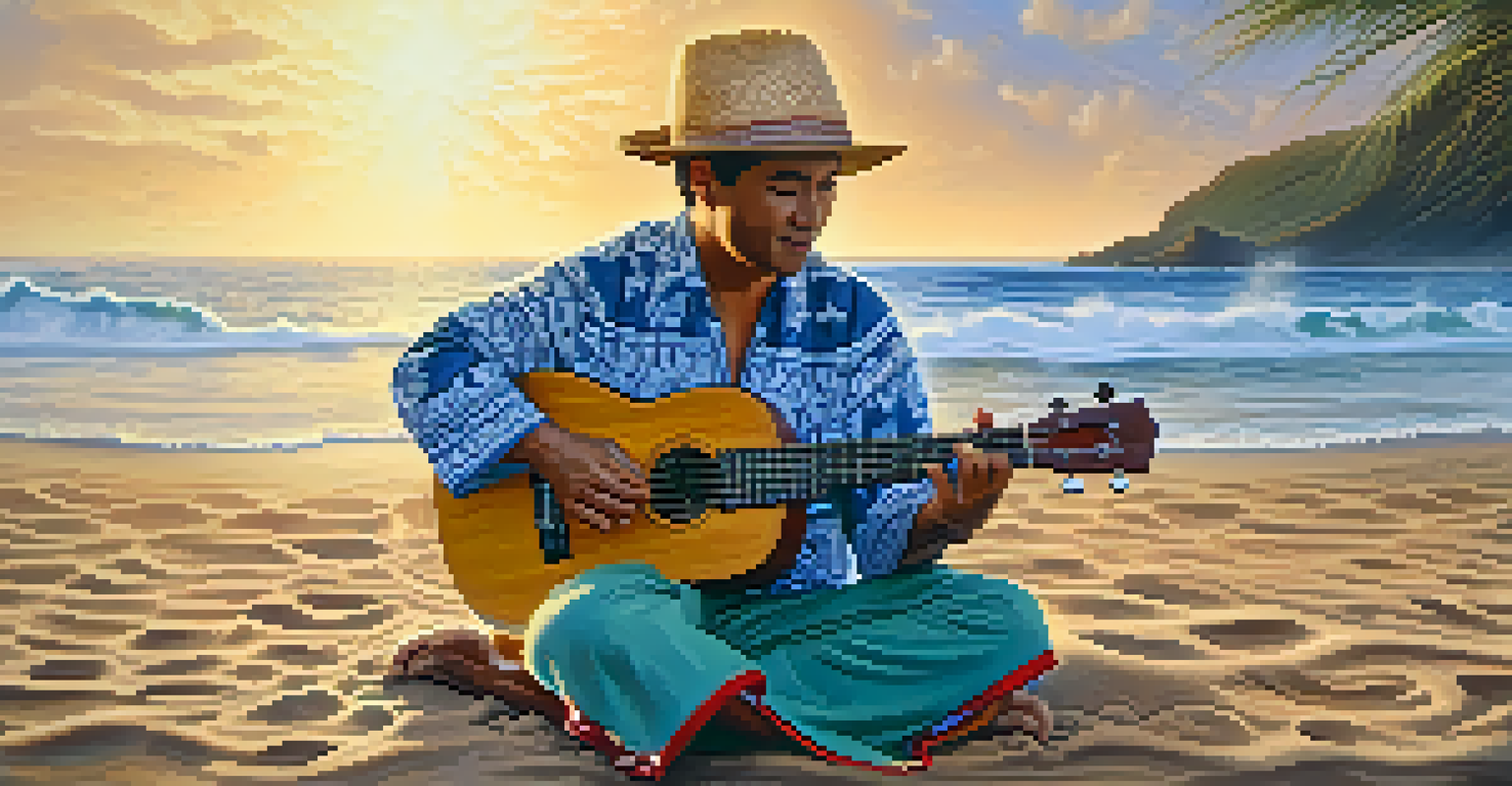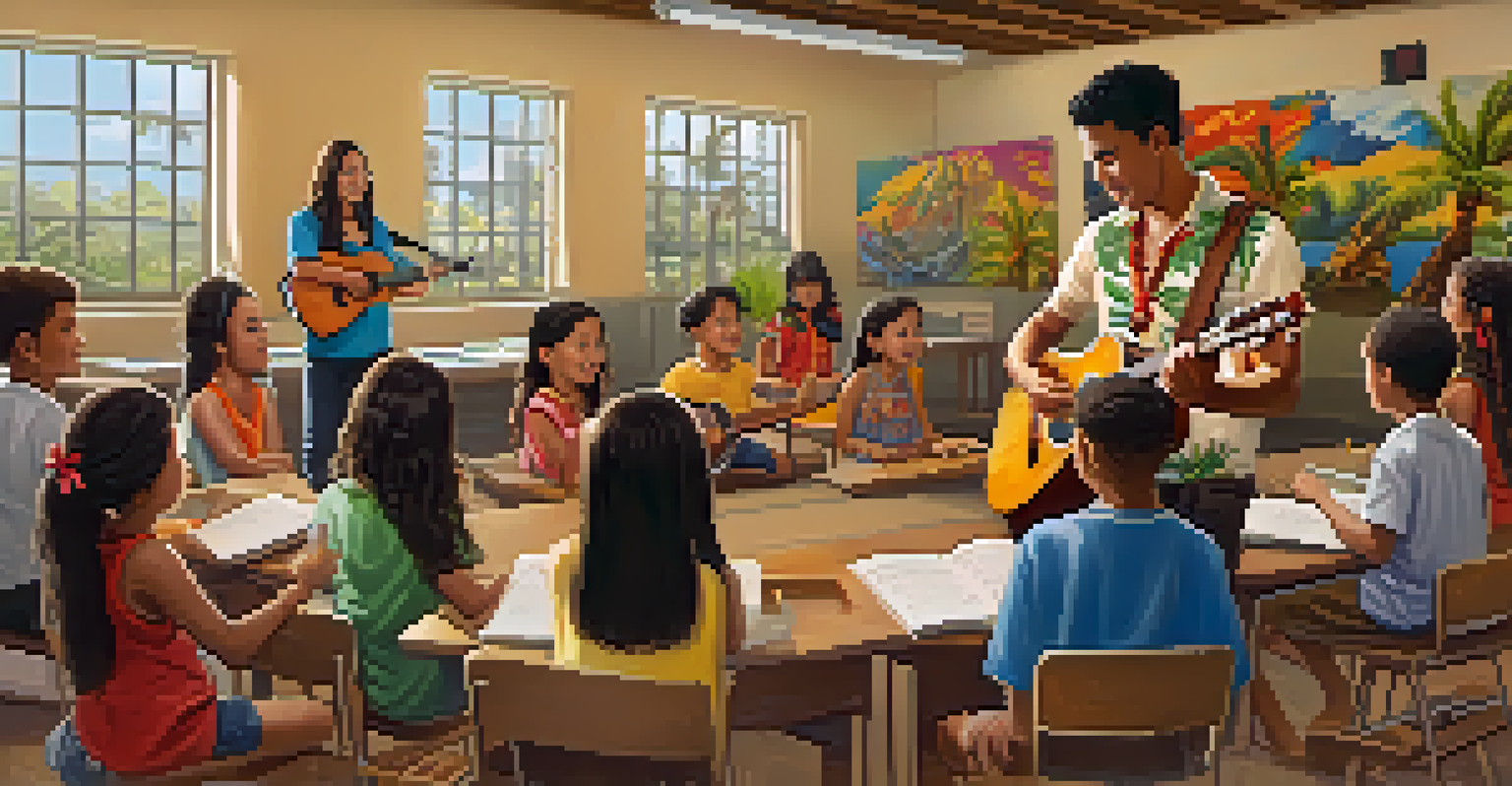Hawaiian Language in Music: A Contemporary Revival

The Historical Roots of Hawaiian Language in Music
Hawaiian music has deep historical roots, with traditions that trace back centuries. The language itself is intertwined with the cultural practices of the Hawaiian people, often used to convey stories, legends, and the beauty of their islands. This oral tradition was crucial in preserving the language, especially during tough times when outside influences threatened its use.
Music is the shorthand of emotion.
In ancient times, chants known as 'mele' were a primary way to communicate history and spirituality. These chants were performed during ceremonies and gatherings, making them a vital part of community life. The melodies and rhythms of Hawaiian music often reflect the natural beauty and cultural significance of the islands, using the language as a medium to connect with the past.
However, as Western influences grew, the Hawaiian language faced significant decline. This led to a loss of many traditional musical forms, but the resilience of the language persisted, waiting for a revival in the modern era.
The Modern Resurgence of Hawaiian Language Music
In recent years, there has been a noticeable resurgence of interest in the Hawaiian language within contemporary music. Artists are increasingly using Hawaiian lyrics to reach both local and global audiences, blending traditional sounds with modern genres. This revival is not just about nostalgia; it reflects a broader cultural consciousness among Hawaiians seeking to reclaim their identity.

Musicians like Israel Kamakawiwo'ole and the group Hōkū Zuttermeister have played pivotal roles in this movement. Their songs resonate with both Hawaiian and non-Hawaiian listeners, showcasing the beauty of the language through accessible music styles. By incorporating Hawaiian into their lyrics, they encourage a new generation to learn and appreciate the language.
Revival of Hawaiian Language in Music
There is a growing trend of artists incorporating Hawaiian language into contemporary music, reflecting a desire to reclaim cultural identity.
Social media platforms and streaming services have also facilitated this revival, allowing artists to share their work widely. The growing popularity of Hawaiian language music is a testament to the islanders' pride in their heritage and their efforts to keep the language alive.
The Influence of Cultural Identity on Music
Cultural identity plays a significant role in how music is created and consumed in Hawaii. For many artists, using the Hawaiian language in their lyrics is a way to express their identity and connect with their roots. This personal connection often translates into more heartfelt and relatable music, resonating with listeners on a deeper level.
Language is the roadmap of a culture. It tells you where its people come from and where they are going.
Incorporating the Hawaiian language not only honors the past but also serves as a reminder of the ongoing journey toward cultural preservation. Many musicians view their work as a means of activism, advocating for the language's survival and importance in today's world. This approach has fostered a sense of community among artists and fans alike.
Moreover, embracing cultural identity through music has opened doors for collaboration across different genres. Whether blending reggae, pop, or hip-hop with traditional Hawaiian elements, artists are creating a rich tapestry that reflects a multifaceted cultural experience.
Educational Initiatives Supporting Hawaiian Language Revival
Many educational initiatives are supporting the revitalization of the Hawaiian language, particularly in music. Schools and community programs are incorporating Hawaiian music into their curriculums, teaching students both the language and its cultural significance. This hands-on approach helps foster a connection to the language from a young age.
Organizations like the Hawaiian Language Immersion Program and the Kamehameha Schools play a critical role in this effort. They not only focus on language education but also emphasize the importance of music and cultural practices in maintaining Hawaiian heritage. By integrating these elements, they create a holistic learning experience.
Cultural Identity Shapes Music Creation
Using the Hawaiian language in lyrics allows artists to express their cultural roots, fostering a deeper connection with listeners.
Through workshops, music camps, and community events, young musicians are encouraged to write and perform in Hawaiian. This not only advances their musical skills but also instills a sense of pride in their heritage, ensuring the language's survival for future generations.
The Role of Festivals and Live Performances
Festivals and live performances are vital in promoting Hawaiian language music and bringing the community together. Events like the Merrie Monarch Festival celebrate hula and music, showcasing the Hawaiian language in a vibrant, lively setting. These gatherings attract both locals and tourists, creating a unique opportunity to experience Hawaiian culture firsthand.
During these festivals, artists often perform original pieces that incorporate Hawaiian lyrics, drawing attention to the language's beauty and relevance. The atmosphere is electric, with audiences singing along and participating in the celebration of their shared heritage. This communal experience reinforces the language’s importance in cultural expression.
Additionally, live performances often include storytelling, further deepening the connection between the language and the music. By sharing personal stories and cultural narratives, artists create a rich tapestry that captures the essence of Hawaiian life, inviting others to join in the celebration.
The Impact of Globalization on Hawaiian Music
Globalization has brought both challenges and opportunities for Hawaiian language music. While it has made it easier for artists to reach international audiences, it has also led to concerns about cultural appropriation. Striking a balance between sharing Hawaiian culture and maintaining its authenticity is an ongoing conversation among musicians and fans.
Many artists are mindful of their roots and strive to keep their music grounded in Hawaiian traditions. This commitment to authenticity often resonates with listeners who appreciate the genuine representation of Hawaiian culture. In a world where music is increasingly commercialized, this dedication stands out.
Educational Efforts Enhance Language Use
Educational initiatives and community programs are crucial in teaching the Hawaiian language through music, ensuring its preservation for future generations.
Moreover, the blend of Hawaiian language and contemporary sounds has created a unique genre that appeals to diverse audiences. By embracing modern influences while staying true to their heritage, artists are carving out a niche that celebrates the richness of Hawaiian culture.
Looking Ahead: The Future of Hawaiian Language in Music
The future of the Hawaiian language in music looks promising as more artists embrace their cultural identity. With the continued growth of interest in Hawaiian music, we can expect to see new talent emerging on the scene. This influx of creativity will likely inspire further exploration of the language and its potential in various music genres.
As educational initiatives and community programs continue to thrive, the language will remain an integral part of Hawaiian music. Young musicians equipped with the skills and knowledge of their cultural heritage are the key to ensuring the language's survival. Their fresh perspectives and innovative approaches can breathe new life into traditional forms.

Ultimately, the revival of the Hawaiian language in music reflects a broader movement toward cultural preservation and identity. As artists continue to weave the language into their work, they not only honor their ancestors but also inspire future generations to celebrate and cherish their heritage.